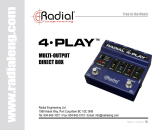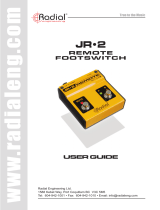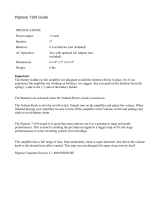
True to the Music
Radial Engineering Ltd. PZ-Pre
™
User Guide
3-Band Semi-Parametric EQ
This three-band semi-parametric EQ is shared between the two
inputs. HIGH and LOW are shelving type EQ and adjust the
treble and bass response. The sweepable midrange EQ uses two
controls: MID controls the amount of boost or cut, while FREQ
sweeps the frequency spectrum.
7
Phase Reverse (¼” Stage Amp Output)
Technically speaking, this is actually
a polarity reverse switch that lets you
toggle the polarity of the signal at the
¼” instrument OUTPUT. This switch is
used to help reduce feedback when the
monitors or PA system coincide with the
instrument amp to cause a feedback
hot-spot where the performer is situated
on stage.
Boost and Effects Loop
The PZ-Pre is equipped with a power
booster and effects loop that can be
kicked in to create dynamic solos or
avant-garde textures. The power boost
and effects loop may be activated together
or separately, depending on the position
of the FOOTSWITCH ASSIGN switch.
Boost
When the FOOTSWITCH ASSIGN is
set to BOOST, depressing the BOOST
footswitch will only turn on and off the
variable power booster (effects loop is
bypassed). The BOOST knob sets the
level of the power booster with a maximum
of +12dB of clean boost. When set to
BOTH, depressing the footswitch will turn
both the effects loop and power booster on
or off. An LED illuminates when the loop,
booster, or both, are active.
Effects Loop
The ¼” effects loop SEND and RETURN
jacks are used to interface with standard
guitar effects pedals such as reverb, chorus
and delay. When the FOOTSWITCH
ASSIGN is set to LOOP, depressing the
BOOST footswitch will only turn on and
off the effects loop (power booster is
bypassed). The effect loop can be set to
stay on all the time by using the LOOP
ON switch next to the stage amp output.
Effects Loop


























